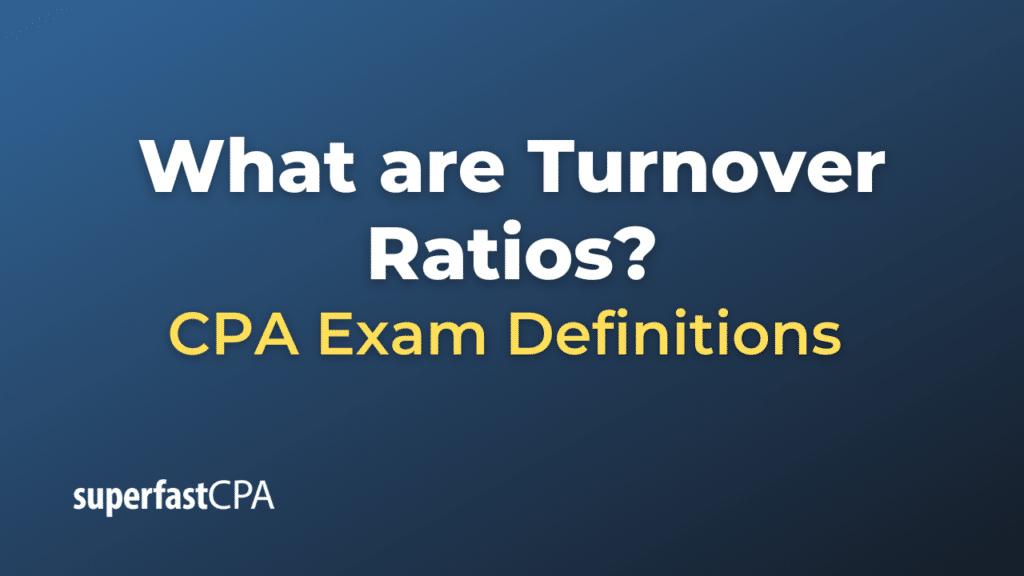Turnover Ratios
Turnover ratios, often used in financial analysis, measure the efficiency with which a company uses its assets or liabilities in its operations. These ratios highlight how quickly assets are converted into sales or how often a company’s assets are “turned over” in a given time period. The main turnover ratios include:
- Inventory Turnover Ratio: This ratio indicates how many times a company’s inventory is sold and replaced over a period. A high inventory turnover is typically seen as a sign of efficiency because it means the company is selling its products quickly.
Inventory Turnover = Cost of Goods Sold (COGS) / Average Inventory - Receivables Turnover Ratio: This measures how efficiently a company is collecting its accounts receivable. A higher ratio is favorable as it indicates that the company collects its outstanding credits more frequently.
Receivables Turnover = Net Credit Sales / Average Accounts Receivable - Asset Turnover Ratio: It shows the sales generated for every dollar’s worth of assets. It measures a firm’s efficiency in using its assets to produce sales.
Asset Turnover = Net Sales / Average Total Assets - Fixed Asset Turnover Ratio: This ratio indicates how well the business is using its fixed assets (like plant and equipment) to generate sales. A higher ratio means the company is more efficient at generating sales from its fixed assets.
Fixed Asset Turnover = Net Sales / Average Net Fixed Assets - Payables Turnover Ratio: This ratio measures how frequently a company pays its suppliers. A lower payables turnover ratio could mean that a company is taking longer to pay its suppliers.
Payables Turnover = Total Purchases / Average Accounts Payable - Equity Turnover Ratio: This measures the amount of sales generated for every dollar of equity invested in the company.
Equity Turnover = Net Sales / Average Equity
For all these ratios, the “average” usually refers to the average between the beginning and ending balance of a given period (e.g., the start and end of a year).
When analyzing these ratios, it’s crucial to compare them to industry benchmarks or the ratios of similar companies, as what’s considered a “good” turnover ratio can vary widely by industry.
Example of Turnover Ratios
Let’s delve into an example of one of the turnover ratios: the Inventory Turnover Ratio.
Imagine a company named “RetailGoods Inc.” which operates in the retail sector.
From their financial statements, we have:
- Cost of Goods Sold (COGS) for the year = $500,000
- Inventory at the start of the year = $50,000
- Inventory at the end of the year = $60,000
To calculate the Inventory Turnover Ratio, we use the formula:
Inventory Turnover = COGS / Average Inventory
First, find the average inventory for the year:
Average Inventory = Inventory at Start + Inventory at End / 2
Average Inventory = $50,000 + $60,000 / 2 = $55,000
Now, plug this into the inventory turnover formula:
Inventory Turnover = $500,000 / $55,000} = 9.09
So, “RetailGoods Inc.” has an inventory turnover of approximately 9.09. This means that the company sold and replaced its inventory about 9 times during the year.
To interpret this:
- If the industry average is, let’s say, 7 times a year, then “RetailGoods Inc.” is more efficient than the average company in its industry at selling and restocking its inventory.
- If the industry average is, let’s say, 12 times a year, then “RetailGoods Inc.” might need to work on improving its inventory management to keep up with its peers.
Remember, while the raw number gives insights, the true value of such ratios comes from comparative analysis against benchmarks or competitors.













